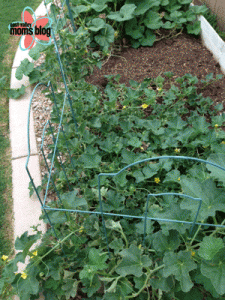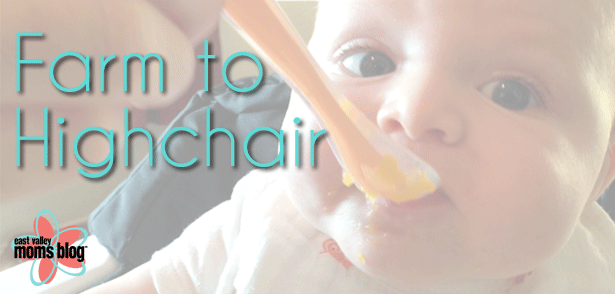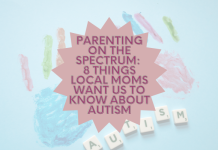One of the best things about living in Arizona is the year round growing season. I always enjoyed gardening back in Boston, but the season is very short and thus limits the variety of foods you can grow. Desert living has allowed me to expand my potential backyard harvest. There have been many lessons learned (and dead plants along the way), but throughout the years there have been great successes and I’m so excited to share this healthful hobby with my son.
It only occurred to me a few years ago that you could make your own “baby food”, or purees, to introduce young children to solid foods. I wasn’t a parent at the time, so I hadn’t given much thought to it. I picked up one of Tyler Florence’s cookbooks in the Barnes & Noble sales bin and amongst delicious recipes for flank steak and roast chicken was an entire chapter dedicated to making purees for babies. Some were basic, like peas with mint, other were more exciting like a blended version of his spaghetti Bolognese. “Of course,” I thought, “why mess with bland jarred food, when you could save some money and make something more interesting on your own.”
How to feed a baby is, of course, one of the many things you learn about when you’re pregnant. But since they don’t start with solids, and breastfeeding is an entirely different challenge to take on, I figured one step at a time. I didn’t even put solid feeding items on my baby shower registry. It seemed so far off in the future at the time. But six months came very quickly and before I knew it, it was time to try some solid foods.
I’ll be honest, my little man hasn’t eaten anything from our yard just yet, since all I have planted is butternut squash and cantaloupe and they are not fully grown as I write this (I mean, I have a 7 month old. I’ve been busy!) But luckily the East Valley is chock full of farmer’s markets where you can pick up locally grown veggies and fruits while supporting your neighbor farmers:
- The Farm at Agritopia, Gilbert (Wednesdays)
- Chandler Farmer’s Market (Thursdays)
- Mesa Community Farmer’s Market (Fridays)
- Gilbert Farmer’s Market (Saturdays)
- Ahwatukee Farmer’s Market (Sundays)
- Tempe Farmer’s Market (Daily)
Gather your ingredients. If you have a true beginner eater like me, try the basic starter foods: avocados, bananas, pears, peaches, apples, squash, carrots and sweet potatoes. We’ve gone through all of these so far. Of course, some will be in season and some won’t, depending on the age of your child and when you start them on solids. Some may not be grown here (Arizonian banana? Not that I’m aware of). So you do your best to pick and choose.
 If you’re looking to grow your own at home, I’ve had success with butternut squash, carrots, watermelon, cantaloupe and peas in my backyard garden. These are all good for babies. Others I’ve grown (and can be introduced down the road) include roma tomatoes, cucumbers, brussel sprouts, lettuce, garlic, leeks, and pumpkin (plant in July to have carve-able pumpkins for Halloween!) We also have lemon, lime and orange trees which should give us our first harvest this winter.
If you’re looking to grow your own at home, I’ve had success with butternut squash, carrots, watermelon, cantaloupe and peas in my backyard garden. These are all good for babies. Others I’ve grown (and can be introduced down the road) include roma tomatoes, cucumbers, brussel sprouts, lettuce, garlic, leeks, and pumpkin (plant in July to have carve-able pumpkins for Halloween!) We also have lemon, lime and orange trees which should give us our first harvest this winter.
This calendar shows you what to plant and when for success in our desert climate.
We have a raised bed garden with nutrient rich soil. It takes a lot of water to keep these foods growing, so I point my lawn sprinklers to cover the garden bed. Then I also “flood” the raised bed once a week with the hose, or more in the summer, to ensure water is really getting down deep into the ground so the roots can grow.
Make your meals. So you have your backyard-grown squash or peach from the farmer’s market, but now what? You’ve probably “pinned” a few of those “make your own baby food” posts, but haven’t looked back at them. Well, at first its pretty easy. Introduce one food to baby at a time, over the period of 4-5 days, looking for allergic reactions.
Baby books and our doctor recommended doing pureed food until at least 9 months, but everyone has a different philosophy on how and when to introduce solids, ranging from only breastmilk or formula for the first year to baby lead weaning. Right now, we’re going right down the middle with just a small amount of purees to compliment our breastfeeding routine.
 I received a Beaba Babycook as a gift and have really been enjoying it, but you can use any food mill or food processor to puree your fruits and veggies. It’s nice because you can steam the food right in the processor and then puree, which locks in all the nutrients. Either way, its a three step process: dice, steam/cook, and then puree. Keep a cup or so of liquid from the steaming process to add to the food when you puree to give it a super smooth texture. I also have the Beaba food portion container, which holds enough portions for one week and makes it easy to freeze them. You can also use a ice cube try to section out freezable portions and defrost daily.
I received a Beaba Babycook as a gift and have really been enjoying it, but you can use any food mill or food processor to puree your fruits and veggies. It’s nice because you can steam the food right in the processor and then puree, which locks in all the nutrients. Either way, its a three step process: dice, steam/cook, and then puree. Keep a cup or so of liquid from the steaming process to add to the food when you puree to give it a super smooth texture. I also have the Beaba food portion container, which holds enough portions for one week and makes it easy to freeze them. You can also use a ice cube try to section out freezable portions and defrost daily.
The sweet foods, of course, have been successful. When we tried spinach, I got a very unhappy grimace. Taste buds change over time, so if you don’t pick a winner, try introducing that one into baby’s diet at a later time. Avocados, bananas and pears have been real hits with my little one.
My plan is to continue introducing new foods in smaller bite sized form as he grows and finally gets some teeth (is teething suppose to take so long? I feel like he’s never going to get teeth!) Melons, broccoli, cauliflower, strawberries and tomatoes are all easy to grow in your backyard and are great for older children. Eventually your backyard harvest can be worked into more exciting recipes like pastas, side dishes and soups.
Foster a lifelong love of the garden. Gardening can be a fun activity for the whole family, and as children grow older, it teaches them about the food cycle and nutrition. It can be a great way to foster ownership and responsibility in older children by letting them pick out the foods they want to grow and making it their job to water the garden each week. Kids and adult alike love to watch plants sprout and develop, then eat the product of their hard work! And you can feel good knowing exactly where your food came from.











